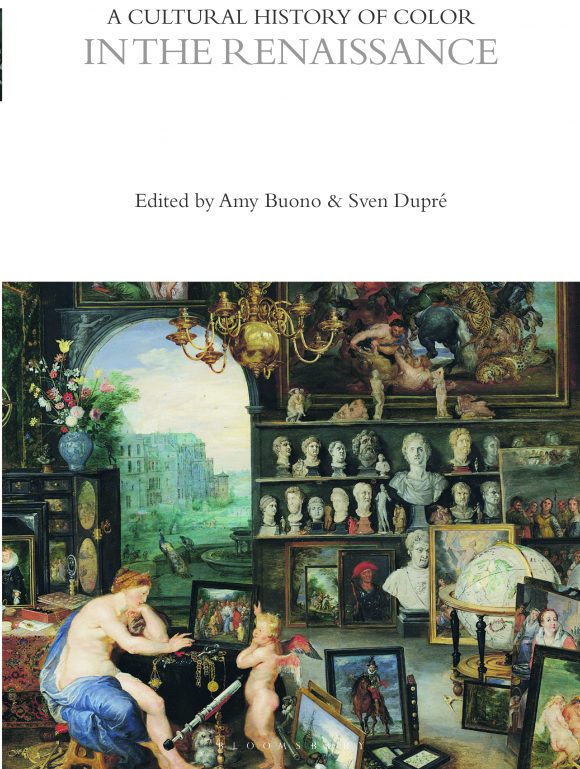Faculty Books: Dr. Amy Buono on the History of Color
February 8, 2021
 With her new book, A Cultural History of Color in the Renaissance, Dr. Amy Buono, Assistant professor in the Department of Art at Wilkinson College, hopes to provide a resource for anyone interested in exploring the rich history of culture and color in early modern Europe. Dr. Buono’s book is the third volume of the soon to be published collection, “A Cultural History of Color.”
With her new book, A Cultural History of Color in the Renaissance, Dr. Amy Buono, Assistant professor in the Department of Art at Wilkinson College, hopes to provide a resource for anyone interested in exploring the rich history of culture and color in early modern Europe. Dr. Buono’s book is the third volume of the soon to be published collection, “A Cultural History of Color.”
Recently, the Voice of Wilkinson sat down with her to chat about it.
The Voice of Wilkinson: I see that you are an expert in colonial to modern Latin American art, transatlantic visual and material culture, Brazilian visual and material culture, Indigenous studies, art and anthropology, and the history and theory of museums. What drew you to this project?
Amy Buono: Fundamentally, I see myself as a cultural historian invested in the knowledge systems of the early modern world, that is, in understanding how different people knew the world at that time. The subject matter of this particular book project emerged during a residential fellowship I had at the Max Planck Institute in Berlin in 2013 working with my colleague and co-editor Sven Dupré (now Chair in Art History at the University of Utrecht, Netherlands). At the time, Sven was leading a research group devoted to investigating the interdisciplinary nature of color practices in early modern world. I was researching indigenous Brazilian featherworking, including an unusual technique that actually changed the color of feathers grown by living birds.
VoW: The book description states that: “Color shapes an individual’s experience of the world and how society gives particular spaces, objects, and moments meaning.” Is there a specific example of this from the volume?
AB: One of the most interesting areas of investigation with color is that of language and psychology. One of our contributors, Doris Oltregge, a researcher in art technology and illumination at the Technical University of Cologne, Germany, wrote a fascinating essay on the ways that color terminology of the period is related to color perception, as well as providing insight into the cultural significance that different hues had in communities across Europe in the early modern period. Her essay does a deep dive into color semantics to distinguish differences between abstract cognitive categories and more specific color terms in early modern Germanic and Romance languages.
VoW: It also states: “The themes covered in each volume are color philosophy and science; color technology and trade; power and identity; religion and ritual; body and clothing; language and psychology; literature and the performing arts; art; architecture and interiors; and artefacts.” I would love to know more about these themes. I think some make more direct sense (such as art, clothing, and interiors) than others. Could you tell me about the ways color influenced literature, religion, and psychology during the Renaissance?
AB: Yes, you are so right. Some of these themes certainly appear to be more straightforward than others. It’s easier to imagine the power of color when discussing pigments and trade, or painterly or architectural surfaces, than it is within psychology or literature. However, the worlds of early modern literature, theater and music in Europe were deeply intermeshed with broader intellectual currents and debates around color in the arts and sciences of the period. For example, Professor Bruce Smith, a colleague in English and Theater at University of Southern California, wrote the literature and performing arts essay for our volume. His piece does a beautiful job of exploring the value systems attached to color in Renaissance theater, for example, where he examines how writers and poets not only used words to refer to particular hues, but how musicians were trained to think of harmonic intervals and embellishments as “chromatic.” In addition, the color and effect of theater costumes functioned to convey meaning, just as the lighting of theater spaces with candlelight was manipulated to convey particular rhetorical ideas, etc. So early modern color was both something extremely fixed in substance and also extremely enigmatic and shifting in terms of meaning, value and deployment. Similarly, religion was deeply invested in color, including in symbolic terms. One way that psychology was understood was in relation to the four temperaments –– sanguine, choleric, melancholic and phlegmatic –– and each of these was related to a color, respectively red, yellow, black and white.
VoOW: Is A Cultural History of Color purely academic, or is it accessible to a non-academic audience?
ABDr. Buono: This is a great question. This book is published by the academic arm of Bloomsbury Press in London, but the goal of the multi-volume series is to provide an historical overview of color to a non-specialized readership coming from both the academic and non-academic worlds. So it is somewhere in-between. These are meant to be accessible overviews of color, written in English, and with predominantly English-language bibliographic resources for each theme. My hope is that these essays help stimulate and inform future research, museum exhibitions, and non-academic work.
VoW: Any final thoughts?
AB: Here at Chapman, I teach an advanced seminar in the Art History program called “Chromophobia/Chromophilia: Color and the Making of the Atlantic World,” that explores color in a transcultural and interdisciplinary framework. As more and more books and studies come out on the impact of color on our collective consciousness, the more important it is to realize how color has shaped cultural, racial, economic lives across time, and across the globe. It has been a wonderful experience for me, learning from my colleagues in a multi-dimensional way about color; I hope readers who encounter the book will learn to think through color more deeply, both in the past and in our own lives!


